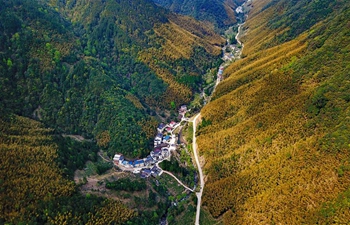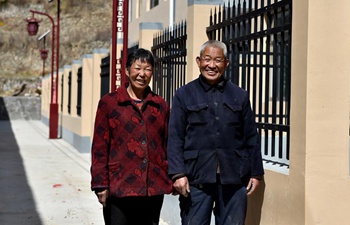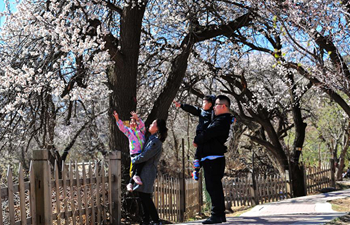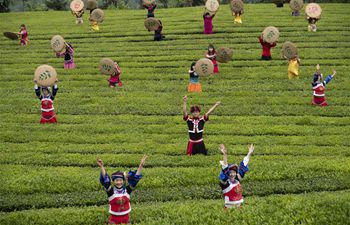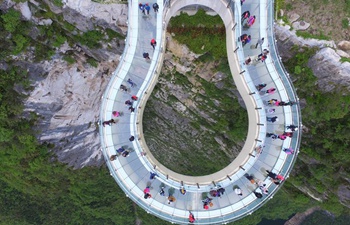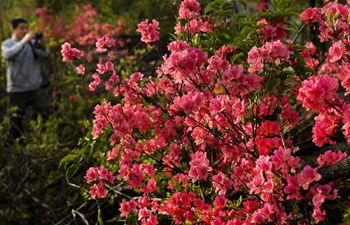HAIKOU, April 16 (Xinhua) -- Under the betel trees of Beireng Village in China's tropical island of Hainan, Wang Qiuxiang's coffee stall always does brisk business, even if her menu is more expensive than those of some boutique coffee shops in the city.
Wang, 46, learned to make coffee from her father, who learned the trade from his parents. Wang's grandparents migrated to Singapore and ran a snack bar. Every morning, the couple made coffee with beans they had grown and roasted themselves for workers at a nearby rubber plantation.
After quitting a job at a four-star hotel in Qionghai City, Hainan Province, where she worked for 17 years, Wang returned to Beireng, her hometown, to start a coffee business in 2014. At the time, the local government was cleaning up the village and planning to develop tourism.
"Piles of garbage and sewage used to be everywhere in the village.Villagers themselves were leaving. Why would any tourist want to come?" Wang said.
Now, with its idyllic setting and well-preserved old buildings, the village of 162 residents receives thousands of tourists each day. It was recognized as one of the most beautiful and livable villages by the housing and urban-rural development ministry in 2016.
"We cherish our clean water and green hills. We clearly know that they can make money and bring us better lives," said villager Lin Zonghao.
Beireng is a model of Hainan's increasing environmental awareness in supporting local health and economic development.
The province's natural environment is already the best in the country. Air quality in the provincial capital of Haikou has ranked first among 74 major cities for five consecutive years and the province's forest coverage has grown by 65 percent during the past three decades to its current 32.04 million mu (2.14 million hectares), according to statistics from the local environmental protection department and forestry department.
The Communist Party of China Central Committee has decided to support the province, which was founded 30 years ago, to build a national ecological development pilot zone, with the country's strictest ecological and environmental protection mechanism and a modern regulation mechanism.
"The good environment is the biggest asset for Hainan. The foundation for green development is preservation of the environment," said Professor Ge Chengjun with Hainan University.
Since 2013, the provincial environmental protection department has issued dozens of regulations, including a rule establishing a red line for protected coastal areas covering more than 19,800 square km.
To balance environmental protection and development, the local government has stopped assessing the economic performances of 12 cities and counties in terms of GDP and fixed asset investment starting this year.
Across the island, the province is prioritizing the development of 12 environment-friendly industries, such as tourism, internet, agriculture, and healthcare. A software park in Chengmai County has attracted about 2,500 companies, including heavyweights Tencent, Baidu, and Huawei.
In addition, Hainan plans to have all its vehicles run on new energy by 2030 to cut emissions. With about 1.18 million vehicles, the province plans to introduce 5,600 new energy vehicles into the market and build more than 10,000 recharging posts this year.
Since Sansha City was established in 2012 to administer the Xisha, Zhongsha and Nansha islands and their surrounding waters in the South China Sea, the city government has intensified measures to improve the environment of the islands.
Last year, the city began piloting an "island chief" scheme in Qilianyu Islands to control pollutant discharge, protect sea turtles and restore the environment on the islands.
Thanks to the efforts of the island chiefs and reef protectors, more than 170 sea turtle nests were spotted during breeding season in 2017, compared with some 50 recorded in 2014.
Despite the progress, Hainan still faces challenges, such as water pollution and environmental damage caused by real estate development.
Earlier this month, the provincial government issued a three-year work plan to eliminate filthy bodies of water in cities by 2020. The government also aims to raise the proportion of villages with sewage treatment facilities to 30 percent and will shut down or relocate some large farms by the end of this year.
Hainan is working to reduce its reliance on the lucrative real estate industry, as home buyers across the country have been flooding into the tropical island.
Starting in late September, Qiongzhong, Baisha, Baoting counties and Wuzhishan City in central Hainan stopped approving construction of new property projects to be sold to buyers from outside the province in order to protect the environment.
"Hainan cannot be a 'processing plant' for real estate. We cannot build as many houses as buyers outside Hainan want," Liu Cigui, Party chief of Hainan, told reporters during the annual national legislative session in March.





